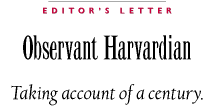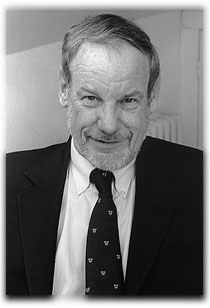Main Menu · Search ·Current Issue ·Contact ·Archives ·Centennial ·Letters to the Editor ·FAQs


|
Tourists making their rounds of the Yard--photographing "the statue of three lies," hearing the story of Harry Elkins Widener and the Titanic, remarking the soaring steeple of Memorial Church--seek in the physical surroundings something important about the enterprise conducted here, and about the people whose lives were formed by their Harvard experiences.
The place evokes deeper feelings from those who have studied and matured and taught and discovered at Harvard. These people may remember Grays or Matthews not for the fineness of their brick but for a particular room where a paper took shape or a friendship began. They may see less the mass of Widener than a well-remembered shelf of books in its stacks. They may resonate most strongly not to the bell of Memorial Church but to a phrase from a prayer, a baccalaureate service, or a Christmas concert conducted inside.
Most of all, Harvard yields its meanings to those who know the history of its shapers and their intent. Fortunately, that knowledge need not repose only in the University Archives. Indeed, it is about to become widely available in a book about Harvard's evolution and growth over the last century. In a subterranean office in Pusey Library, a corridor and a floor away from the archives, John T. Bethell '54, Harvard Magazine's senior editor, is completing an absorbing history of the University from the last decade of Charles William Eliot's 40-year presidency through the present day.
The manuscript itself represents three years of hard labor, but the idea took root much longer ago. As "Primus IV," Bethell has revealed in "The College Pump" that he attended his first Harvard football game on October 11, 1941, when he was nine years old (Cornell won, 7-0). Nine years later, he was enrolled at the College. And a dozen years after graduating, he was back, beginning 28 years of editing this magazine. For more than half of this century, he has had a tangible connection with Harvard. And for the last quarter of the century, he has written and edited more words about the University, and far better ones, than anyone else. He has lived much of Harvard's modern history, and--through texts and pictures--he has imbibed and presented the rest. The magazine's readers have already sampled his work-in-progress through recent features on Harvard's role in World War II and on Franklin Roosevelt. Our centennial timelines also rely on his project.
He has titled his book, to be published this fall in time for the magazine's centennial, Harvard Observed. That seems exactly right not only for the book but for its author--the most acute observer of Harvard, its students and professors, and its alumni for going on six full decades. It also seems exactly right for the Harvard Magazine John Bethell brought to excellence: an affectionate but also independent--and where necessary, skeptical--observer of Harvard.
Today, from our yellow house on Ware Street, close to but outside Harvard Yard, we observe still, on our readers' behalf.
~ John S. Rosenberg